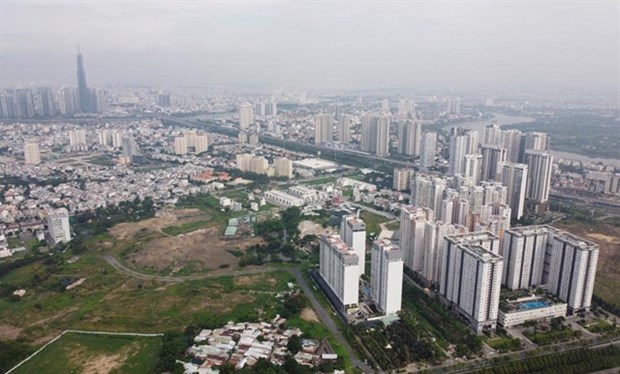Removing land price table to prevent real estate overheating
Removal of the land price framework issued by the Government will make the market more transparent and prevent real estate from skyrocketing, according to Minister of Natural Resources and Environment Tran Hong Ha.
The minister affirmed that removing the land price frame is the right policy in amending the Land Law because the existing land price table has revealed many problems.
When the land price framework of the State is removed, only the land price tables set up by the localities are maintained, and the prices in the tables will be closer to market prices.
With the land price closer to the actual prices on the market, the financial responsibility of enterprises and land users may increase, and the State budget would also surge. This helps the State invest more in socio-economic development, with people benefiting.
Meanwhile, land users will be compensated for the correct land values when the State recovers, which is a direct benefit to land users.
Businesses and the Government also gain a lot of benefits. The new land price table will make the companies shorten the time for site clearance, saving resources and shortening the time to implement investment projects.
However, in the draft law, there are regulatory mechanisms for land prices to not be pushed up too high, avoiding increasing input costs of production and product prices which reduce competitiveness.
"The land price is determined by supply and demand on the market, so the removal of the land price frame will not affect the real estate market," Ha said. "The land allocation or land lease is mainly done in the form of public auction and bidding for projects."
"The State does not interfere in the land prices on the market. However, the State will manage and regulate the real estate market via solutions such as an increase in the land supply for the market, strict management of land planning and the use of tax tools. "
According to the minister, regulating the market is also a way to combat land speculation due to forecasts of land price increases. If the market supply is really scarce, causing property prices to rise, the State needs a land fund to regulate this market.
The land price frame only stipulates the minimum and maximum levels according to regions and geographical areas in the region, being the basis for localities in setting up local land price tables with an adjustment coefficient of at most 30% of that basic price table issued by the Ministry of Natural Resources and Environment.
Meanwhile, the domestic real estate market constantly changes, making this land price table quickly outdated compared to market prices, especially in cities.
For example, at the land price table, the highest land price in special urban areas is 129.6 million VND per sq.m, according to Ha.
This price is allowed to fluctuate at most by 30% to reach more than 164 million VND per sq.m, which is low compared to the market prices in Hang Ngang and Hang Dao streets of Hanoi or the central areas in district 1 of Ho Chi Minh City.
Therefore, the localities have difficulty promulgating land price tables in line with the actual land prices on the market.
The removal of the Government-issued land price frame is expected to help the local authorities set up their land price tables approaching the market prices. That will eliminate the two-price mechanism and increase revenue for the State budget.
Ha said the draft amendment to the Land Law contains specific provisions on the annual land price table.
This land price table calculates land use fees, fees for changing land use purposes, and all kinds of taxes related to the land.
It also calculates land rents for agricultural land and compensation when the State recovers ground.
In the future, the Government will apply financial and tax tools to limit land speculators, Ha said. State management agencies will consider imposing a tax on land lots that are used slowly after auctions because the investors wait for prices to increase.
The State will impose a higher tax on speculators who sell property products immediately after buying.
The land is now abandoned in many places due to suspended projects to wait for an increase in land prices and unused agricultural land, according to Ha.
"The ministry is focusing on building a land price table according to the land value for each region by mapping land prices. Region having many land transactions will soon build a database for land valuation," said Ha, adding that in 2025, Vietnam will have a land database, including a map of land prices.
The country will also have a new land pricing system in the next five years, according to Ha.
He said the task of amending the Land Law this time is to build a multi-purpose land information system. This is a solution to reform administrative procedures, ensure transparency, and monitor land resources. It also is a channel providing information about land policies and guidelines for the people.
The minister affirmed that land is an important resource of the country. The Land Law is revised this time to solve difficulties and create new motivation for socio-economic development.
This means, besides strict management, the State must develop a system of simple and transparent management tools, especially in determining land price tables in localities.
The Government expects to submit the draft of the revised Land Law to the National Assembly in October. By 2023, the amendment of the Land Law 2013 must be completed./.









